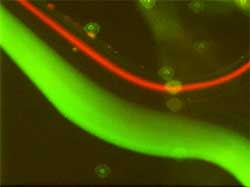DoD awards grant to distinguish aggressive forms of breast cancer that spread in the body
 (Download Image)
A research team led by Lawrence Livermore National Laboratory biomedical scientist Gaby Loots (left) and microtechnology engineer Maxim Shusteff won a three-year DoD grant to study breast cancer metastasis. Photo by Kate Hunts/LLNL.
(Download Image)
A research team led by Lawrence Livermore National Laboratory biomedical scientist Gaby Loots (left) and microtechnology engineer Maxim Shusteff won a three-year DoD grant to study breast cancer metastasis. Photo by Kate Hunts/LLNL.
The Department of Defense (DoD) awarded a team from Lawrence Livermore National Laboratory (LLNL) and UC Merced a three-year, $768,803 grant to study breast cancer metastasis.
Researchers are on the hunt to identify, characterize and potentially exploit the information packaged in different types of extracellular shed vesicles (ESVs) to determine if they can distinguish aggressive forms of breast cancer that rapidly spread in the body. Normally these packets of molecules and genetic information travel from cell to cell performing essential body functions. However, in aggressive cancers, it is hypothesized that those packets can act as scouts to find other organs in the body to expand the cancer’s reach beyond the initial site. Death from cancer almost always results from this spread, called metastasis.
Cancer metastasis has long been modeled as a tumor breaking off and landing somewhere new, where it forms a secondary tumor. New studies suggest that cancer-derived ESVs go to new sites first and make them more favorable for the tumor to land and grow. The team expects to find unique information contained in ESVs derived from tumor cells that manipulate and prime the environment in the bone, a main site of metastasis for breast cancer.
Distinguishing the contents or the rate of aggressive ESVs could help scientists better discriminate between malignant and benign tumors, preventing overtreatment. Researchers hope the project could lead to further research investigating the prevention of metastasis by either intercepting or stopping ESVs from being released altogether, or use their cargo as biomarkers.
"Everyone has been touched by cancer in one form or another. Any information that we can determine that can help by any means would be very fulfilling to me as a scientist," said principal investigator Gaby Loots, a biomedical scientist at LLNL and an adjunct associate professor at UC Merced.
The team will use microfluidic technologies developed at LLNL, which apply ultrasound frequencies to efficiently separate cells from other, smaller particles along tiny channels of fluid. Detecting RNA movement in ESVs from one cell to another is too small to measure with any conventional methods, such as sequencing or PCR, so the team will explore the use of accelerator mass spectrometry (AMS), a method that can quantify picomolar amounts of RNA. "AMS is a way to detect the undetectable," Loots explained.
"As an engineer, it’s great to find ways that our tools can make a long-term impact," said co-principal investigator and LLNL staff microtechnology engineer Maxim Shusteff.
Other members of the research team include Nicholas Hum and Erika Fong from LLNL and collaborator Michael Cleary from UC Merced.
Previous funding for the work was provided by Laboratory Directed Research and Development grants.
Contact
Kate Hunts[email protected]
925-422-1322
Related Links
DoDUC Merced
Laboratory Directed Research and Development grants
Video
Tags
Physical and Life SciencesFeatured Articles








